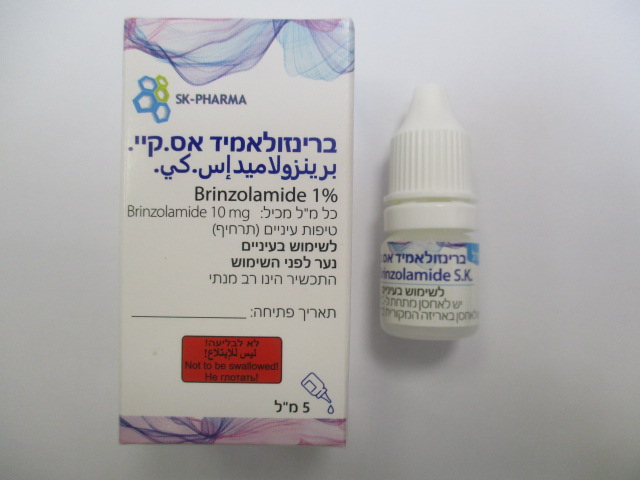Quest for the right Drug

ברינזולאמיד אס.קיי. BRINZOLAMIDE SK (BRINZOLAMIDE)
תרופה במרשם
תרופה בסל
נרקוטיקה
ציטוטוקסיקה
צורת מתן:
עיני : OCULAR
צורת מינון:
תרחיף לעין : EYE DROPS, SUSPENSION
עלון לרופא
מינוניםPosology התוויות
Indications תופעות לוואי
Adverse reactions התוויות נגד
Contraindications אינטראקציות
Interactions מינון יתר
Overdose הריון/הנקה
Pregnancy & Lactation אוכלוסיות מיוחדות
Special populations תכונות פרמקולוגיות
Pharmacological properties מידע רוקחי
Pharmaceutical particulars אזהרת שימוש
Special Warning עלון לרופא
Physicians Leaflet
Special Warning : אזהרת שימוש
4.4 Special warnings and precautions for use Systemic effects BRINZOLAMIDE SK is a sulphonamide inhibitor of carbonic anhydrase and, although administered topically, is absorbed systemically. The same types of adverse drug reactions that are attributable to sulphonamides may occur with topical administration, including Stevens-Johnson syndrome (SJS) and toxic epidermal necrolysis (TEN). At the time of prescription, patients should be advised of the signs and symptoms and monitored closely for skin reactions. If signs of serious reactions or hypersensitivity occur, BRINZOLAMIDE SK should be withdrawn immediately Acid-base disturbances have been reported with oral carbonic anhydrase inhibitors. Use with caution in patients with risk of renal impairment because the possible risk of metabolic acidosis (see section 4.2). Brinzolamide has not been studied in pre-term infants (less than 36 weeks gestational age) or those less than 1 week of age. Patients with significant renal tubular immaturity or abnormalities should only receive brinzolamide after careful consideration of the risk benefit balance because of the possible risk of metabolic acidosis. Oral carbonic anhydrase inhibitors may impair the ability to perform tasks requiring mental alertness and/or physical coordination. BRINZOLAMIDE SK is absorbed systemically and therefore this may occur with topical administration. Concomitant therapy There is a potential for an additive effect on the known systemic effects of carbonic anhydrase inhibition in patients receiving an oral carbonic anhydrase inhibitor and BRINZOLAMIDE SK. The concomitant administration of BRINZOLAMIDE SK and oral carbonic anhydrase inhibitors has not been studied and is not recommended (see also section 4.5). brinzolamide was primarily evaluated in concomitant administration with timolol during adjunctive glaucoma therapy. Additionally the IOP-reducing effect of brinzolamide as adjunctive therapy to the prostaglandin analogue travoprost has been studied. No long term data are available on the use of BRINZOLAMIDE SK as adjunctive therapy to travoprost(see also section 5.1). There is limited experience with BRINZOLAMIDE SK in the treatment of patients with pseudoexfoliative glaucoma or pigmentary glaucoma. Caution should be used in treating these patients and close monitoring of intraocular pressure (IOP) is recommended. brinzolamide has not been studied in patients with narrow-angle glaucoma and its use is not recommended in these patients. The possible role of brinzolamide on corneal endothelial function has not been investigated in patients with compromised corneas (particularly in patients with low endothelial cell count). Specifically, patients wearing contact lenses have not been studied and careful monitoring of these patients when using brinzolamide is recommended, since carbonic anhydrase inhibitors may affect corneal hydration and wearing contact lenses might increase the risk for the cornea. Careful monitoring of patients with compromised corneas such as patients with diabetes mellitus or corneal dystrophies is recommended. Benzalkonium chloride, which is commonly used as a preservative in ophthalmic products, has been reported to cause punctate keratopathy and/or toxic ulcerative keratopathy. Since BRINZOLAMIDE SK contains benzalkonium chloride, close monitoring is required with frequent or prolonged use in dry eye patients, or in conditions where the cornea is compromised. brinzolamide has not been studied in patients wearing contact lenses. BRINZOLAMIDE SK contains benzalkonium chloride which may cause eye irritation and is known to discolour soft contact lenses. Contact with soft contact lenses is to be avoided. Patients must be instructed to remove contact lenses prior to the application of BRINZOLAMIDE SK and wait at least 15 minutes after instillation of the dose before reinsertion. Potential rebound effects following cessation of treatment with BRINZOLAMIDE SK have not been studied; the IOP- lowering effect is expected to last for 5-7 days. Paediatric population The safety and efficacy of BRINZOLAMIDE SK in infants, children and adolescents aged 0 to 17 years have not been established and its use is not recommended in infants, children or adolescents
Effects on Driving
4.7 Effects on ability to drive and use machines BRINZOLAMIDE SK has a minor influence on the ability to drive and use machines. Temporary blurred vision or other visual disturbances may affect the ability to drive or use machines (see also section 4.8). If blurred vision occurs at instillation, the patient must wait until the vision clears before driving or using machines. Oral carbonic anhydrase inhibitors may impair the ability to perform tasks requiring mental alertness and/or physical coordination (see also section 4.4 and section 4.8).

שימוש לפי פנקס קופ''ח כללית 1994
לא צוין
תאריך הכללה מקורי בסל
לא צוין
הגבלות
לא צוין
רישום
163 25 35121 00
מחיר
0 ₪
מידע נוסף
